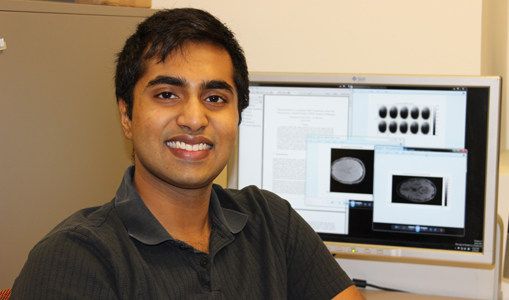Gopal Nataraj receives ISA Fellowship to support research that will improve MRIs
Nataraj’s research aims to generate higher-quality and faster MRI images, resulting in improved diagnostics of neurological disorders and autoimmune diseases.

 Enlarge
Enlarge
Gopal Nataraj, a doctoral student in the Electrical Engineering:Systems program, received a fellowship from Innovative Signal Analysis, Inc. (ISA) to support research that aims to generate higher-quality and faster MRI images than is currently available. The result will be improved diagnostics of neurological disorders and autoimmune diseases, shorter periods of time inside MRI machines by patients, and a reduction in healthcare costs. Mr. Nataraj is a member of Prof. Jeffrey Fessler’s research group.
“Broadly stated,” says Mr. Nataraj, “our research applies model-based methods to better reconstruct different types of magnetic resonance (MR) images. Currently, we are using these methods for quantitative MRI, in which we strive to map different parameters of interest as accurately and precisely as possible. Some of these parameters are thought to be sensitive biomarkers for monitoring the progression of pathology. Thus, improvements in quantitative MRI reconstruction may assist with earlier diagnosis of poorly understood neurological and/or autoimmune disorders, such as Parkinson’s disease, epilepsy, or multiple sclerosis.”
The following in vivo images show the difference between MRI images processed with conventional methods (A and C), and the same images processed with Gopal’s proposed method (B and D).

 Enlarge
Enlarge
In each case, the proposed method resulted in higher precision images within tissue types, while preserving high contrast across tissue types. The improved clarity and brightness of irregularities in human tissue will lead to earlier diagnosis of progressive diseases and disorders that have proven to be particularly difficult to diagnose accurately.
The images are taken from the paper, “Regularized, Joint Estimation of T1 and M0 Maps,” by Gopal Nataraj, Jon-Fredrik Nielson, and Jeffrey Fessler. The results have been submitted to the Annual Meeting of the International Society of Magnetic Resonance in Medicine (ISMRM).
Gopal Nataraj received his bachelor’s degree from Cornell University in both Electrical & Computer Engineering and Applied Physics. He is interested in interdisciplinary opportunities which combine his research interests in medical imaging with industrial applications. He also enjoys tutoring high school and undergraduate students in collegiate mathematics and the physical sciences through private- and small-group sessions.
Related Topics: Fessler, Jefferey Medical diagnosis Medical imaging Signal and Image Processing
 MENU
MENU 
